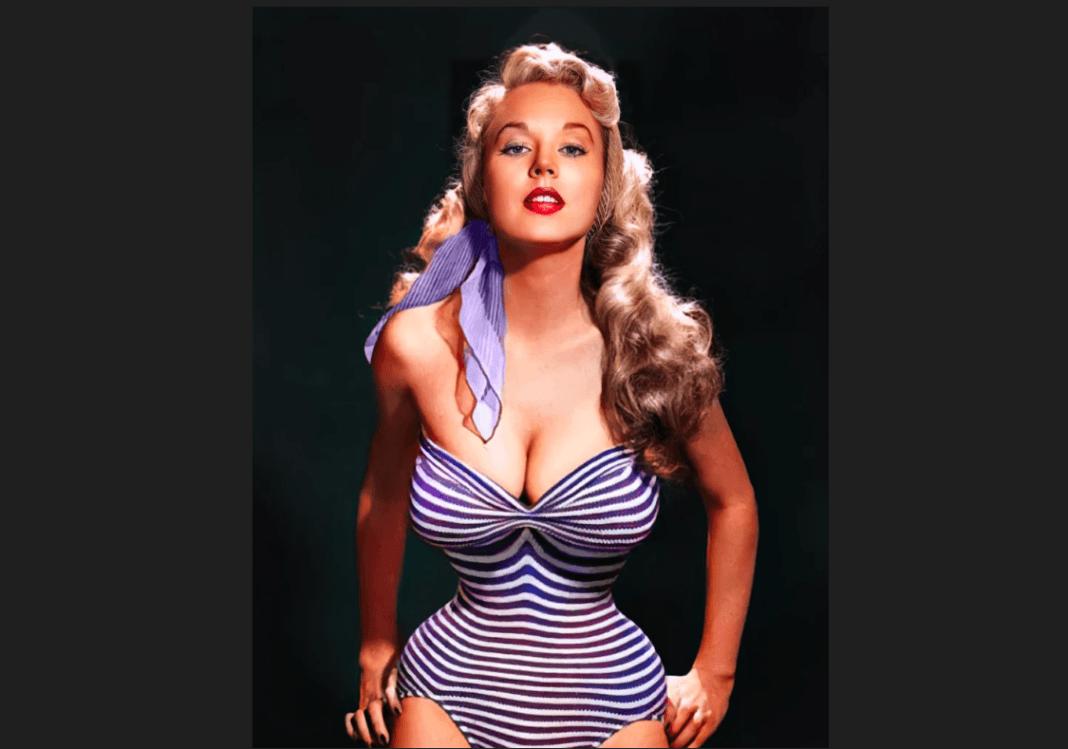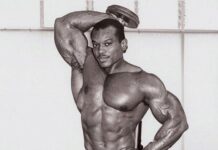“Betty Brosmer is the prettiest paradox you’ll ever meet!”
— Joe Weider (1956)
Betty Brosmer was the ultimate pinup model of the 1950s. Betty Weider was the ultimate female fitness icon of the 1960s and 1970s and 1980s. This is the story of Betty Brosmer and how she became history’s first supermodel. And it’s the story of her scandalous romance with Joe Weider and how she became Betty Weider, the face and figure of female fitness for generations.
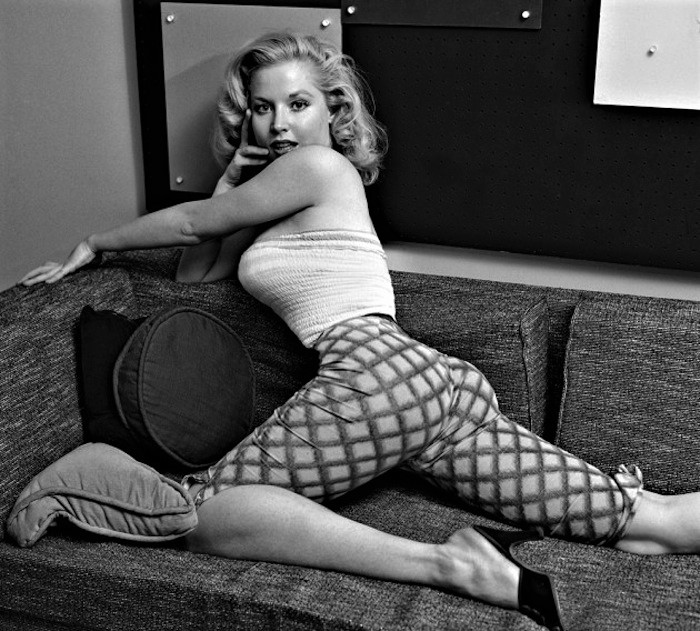
WATSONVILLE: THE BROSEMERS
Nestled between California’s Santa Cruz Mountains and the Pacific Ocean, 70 miles south of San Francisco and just a couple miles from Monterey Bay, on fertile soil where redwoods thrive, and soothed by temperate highs and lows, is idyllic Watsonville. A sign used to hang above Main Street proclaiming the town “The Apple City” because of nearby apple orchards. But it was a hard place too, of long days of brutal farm labor for meager pay.
Immigrants from Belgium, Andrew and Elizabeth Brosemer and their eight children, including Andy, born in 1897, first lived in the silver mining community of Angels Camp, California. Pursuing agricultural work after mines closed, the Brosemers moved to Watsonville. The junior Andy labored on a fruit farm and sometimes on a construction crew, and he sold moonshine during Prohibition.[1]
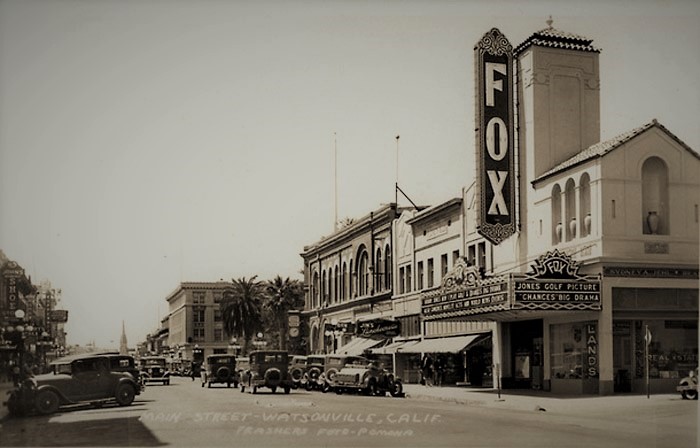
Born in Idaho in 1907, Vendla Pippenger was one of six children. On December 4, 1928, 19-year-old Vendla and 31-year-old Andy Brosemer married in Santa Cruz, California. Almost exactly nine months later, on August 6, 1929, Betty Chloe Brosemer, was born. It was a volatile time. Two months later, the stock market crashed, launching the Great Depression, and three months after that the Watsonville Riots, a clash between whites and Filipinos, roiled for five bloody days. The Brosemers lived in a shotgun shack in Watsonville, a town of less than 9000, first with another young family and then with Andy’s mother and a younger brother.[2]
Their marriage was troubled. In 1932, Andrew petitioned the court to become sole guardian of Betty.[3] He instilled in her a baseball fandom so intense that she could wow adults by reciting major league rosters and batting averages. “I think he wanted a boy, and I was his little boy until my brother came along,” Betty said.[4] Her parents stayed together long enough to have two more children, but they separated in March 1938, and divorced two years later.[5] Raised from age eight by her father and grandmother, away from her mother and younger siblings, tomboy Betty played sports and collected coins.
LOS ANGELES: AUNT ANNIE
Born in 1895, Annie Chamberlain moved from Maine to San Francisco in 1920, where she met and married Andy’s younger brother, a pharmacist.[6] They operated a drug store. When her husband died in 1934, Annie returned to Maine, where her favorite niece, Betty, visited her. Annie relocated across the country again in 1937 to Los Angeles, where, at 41, she enrolled in UCLA. Five years later she was a childless, financially stable, middle-aged widow with a B.A. in French and a lust for learning.
Though she was a Brosemer only by marriage and that connection had severed, she and Betty had bonded. To Andy, laboring at a packing plant, Annie seemed like a good role model for his daughter; and, when his mother died, caring for Betty became difficult. So, in 1942, Andy drove 12-year-old Betty south to Los Angeles to live with her aunt.
Los Angeles, of course, was nothing like Watsonville. The rapidly-expanding metropolis had over 1.5 million citizens, the majority of them transplants from somewhere east. Betty, a child of the Depression, attended school in Westwood and then Beverly Hills and was in close proximity to wealth and celebrity. She and Aunt Annie perused museums, ate in ethnic restaurants, and attended cultural events. They followed Annie’s beloved Red Sox in newspapers and on the radio when they lost the 1946 World Series. “She was always a bundle of energy and possessed a good sense of humor, a lot of common sense, and a great deal of wisdom,” Betty said of the aunt who became her surrogate mother.[7] In interviews in later years, Betty never mentioned her biological mother but effused about Aunt Annie, who lived to be 107.
Annie emphasized healthy eating and fitness. Betty, captain of her softball team, began training with a boys’ weight set. The formerly skinny kid blossomed into a curvaceous 5’5” teenager with the blonde hair, blue eyes, and porcelain skin that mid-century advertisers coveted.
NEW YORK CITY: MODELING
During a two-week vacation in New York City in 1949, Betty Brosemer posed for a photographer in exchange, unfortunately, for only copies of the photos. One of the shots of her gazing into a television appeared in advertisements in magazines, including Life and Time, and on billboards. Back in L.A., Betty modeled in swimsuits for the era’s most celebrated pinup artists: Alberto Vargas, famous for his Esquire painted girls, and Earl Moran, best known for painting Marilyn Monroe.
Moving to New York City in 1950 at 20, the budding model dropped the first “e” from her last name, becoming Betty Brosmer. She soon thrived in her new career. “Once in front of the camera, my shyness seemed to evaporate,” she said.[8] Her starting pay was $15 an hour ($185 today).[9] “I would work practically every day for a time at 480 Lexington Avenue [Grand Central Palace in midtown Manhattan]. Almost all of the top models worked there,” the future Betty Weider remembered.[10] “I didn’t wear enough makeup, and they’d paint you in the photo. Sometimes the photo didn’t even look like me.”[11]
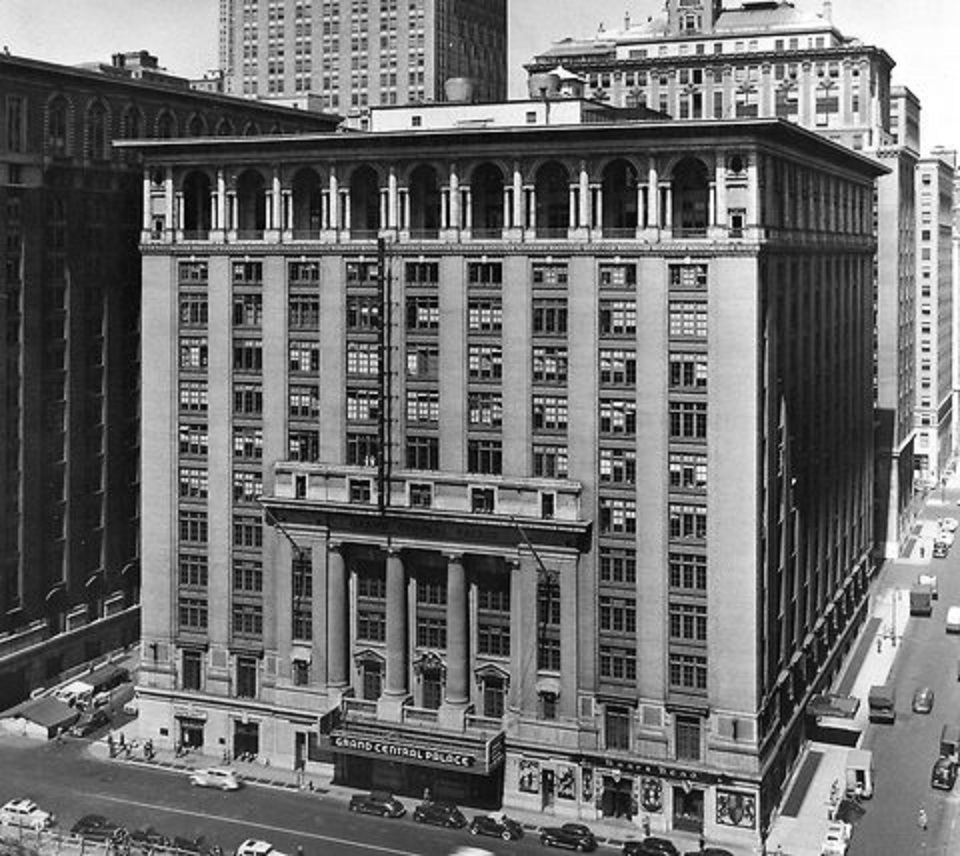
Betty Brosmer’s first cover was the July/August 1950 issue of Gala, a men’s magazine full of almost-but-not-naked women.
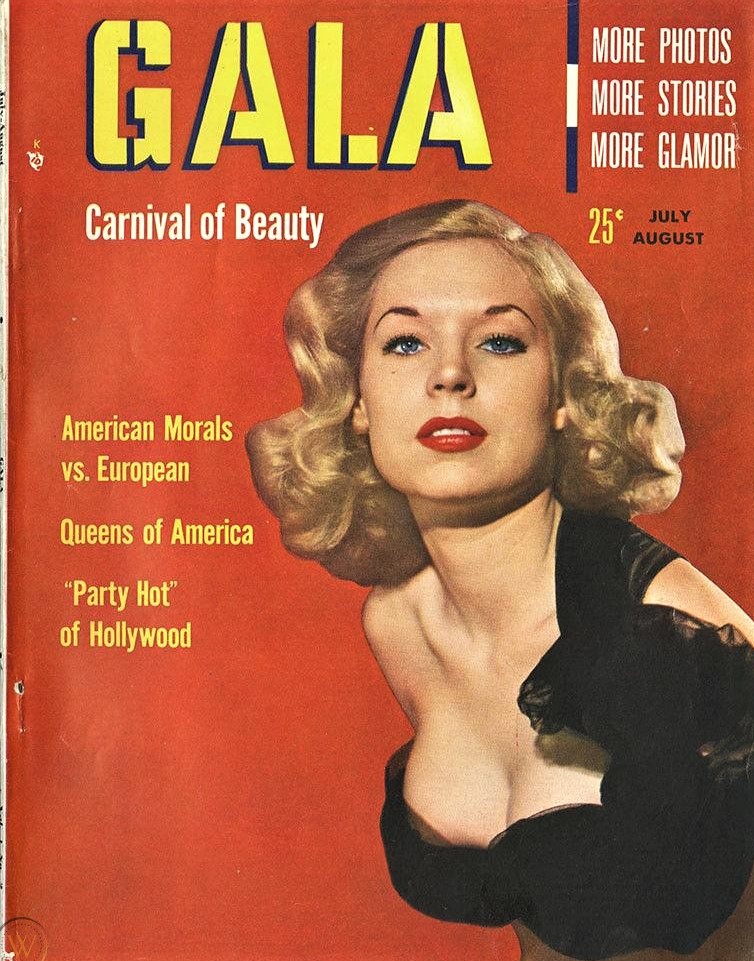
Usually dressed in a bikini or a tight shirt and short shorts to highlight her improbably miniscule waist, she appeared on and in such men’s magazines as Bold, Modern Man, and French Peep Show.
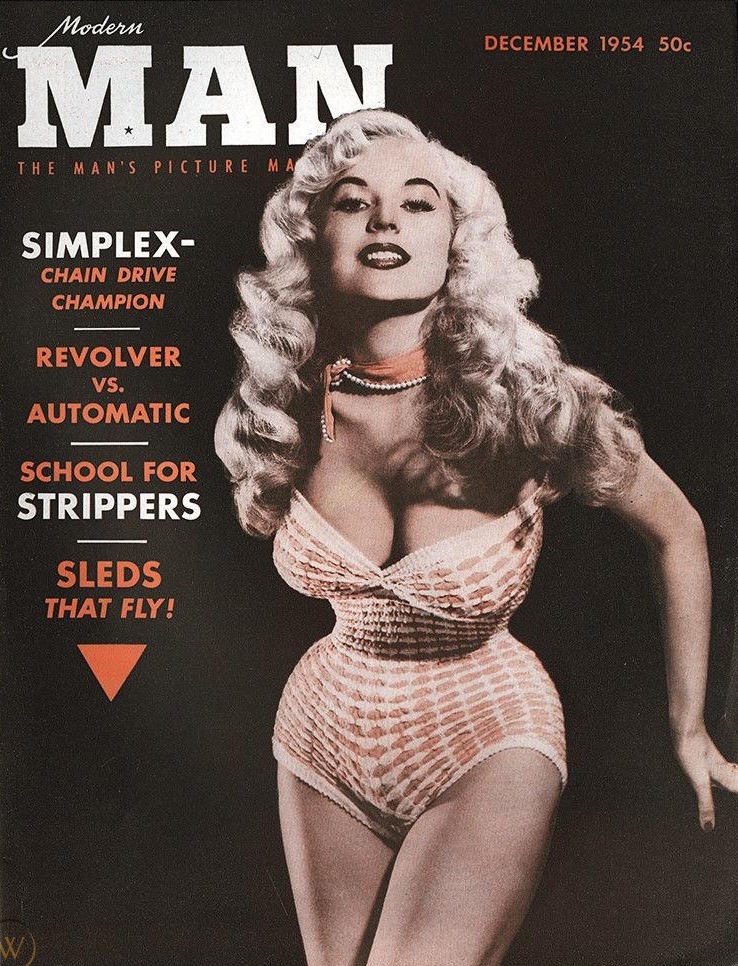
Looking pretty was Betty Brosmer’s only job in a racy Broadway variety show, but it was panned by critics and quickly closed.[12] Representing a New York dressmaker, she toured the country, visiting 44 of the 48 states, appearing in department stores and smiling on local TV programs.[13]
Miss Pretty Girl, Miss Supersonic, Miss Waist and Hips, Miss Potato Chips, Miss Blue Eyes, Miss Prime Rib, and on and on—Brosmer won some 50 beauty pageants in the 1950s. The winner was typically determined by audience applause—or supposedly so. “A lot of those beauty contests were kind of fixed,” Betty admitted. “I felt so sorry for some of those girls. They would get me to a modeling agency and say, ‘Are you prepared to do this’ for the product, as if they knew I would win. Some contests were legitimate by applause meter, but where the winner was supposed to advertise a product, they wanted to make sure you could make appearances on radio and television.”[14]
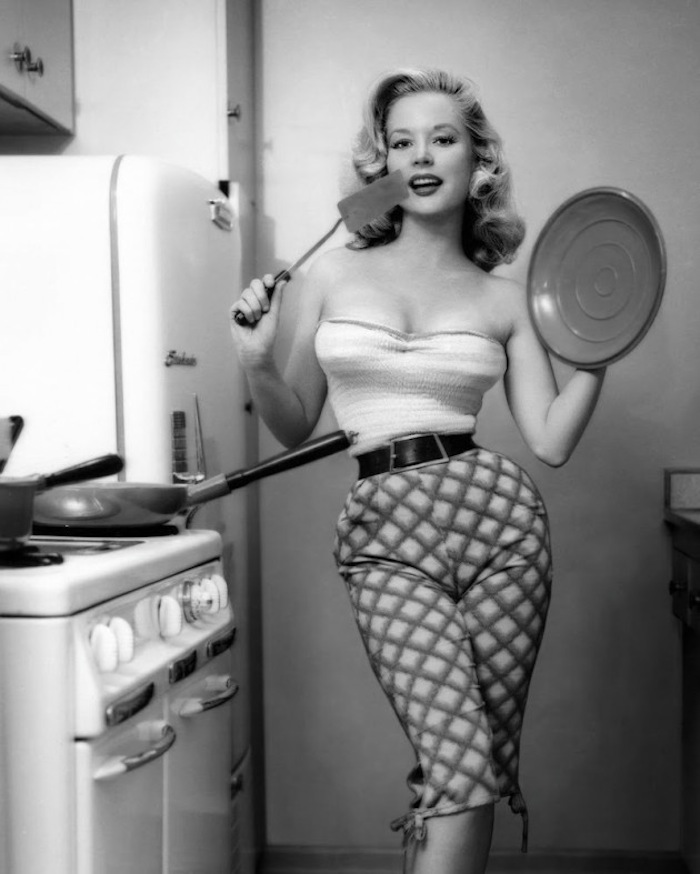
A mere three days of promotions as Miss California Long-Life Potatoes earned her $3000 (approximately the median annual salary for American men then; for women it was $1200).[14] As Miss Television, Brosmer was featured in TV Guide and on television programs hosted by Milton Berle, Jackie Gleason, and Steve Allen. Thereafter, when she posed with products in newspaper stories, she was frequently referred to as “television actress Betty Brosmer,” though Miss Television never acted on TV.
LOS ANGELES: PINUP MODELING
In 1954, Brosmer moved back to Los Angeles and enrolled in UCLA, majoring in psychology. Walter Winchell’s popular newspaper column reported: “New York model Betty Brosmer (in Hollywood) told interviewers: ‘The only thing I miss about New York is the big league baseball.’”[15] The contract she signed with L.A. pinup photographer Keith Bernard (1911-1981) gave him exclusive rights to shoot all her pinups, while Brosmer received one-third of earnings, an unusual deal that proved very lucrative for both of them. “I don’t think he realized how popular I would become,” she said.[16]
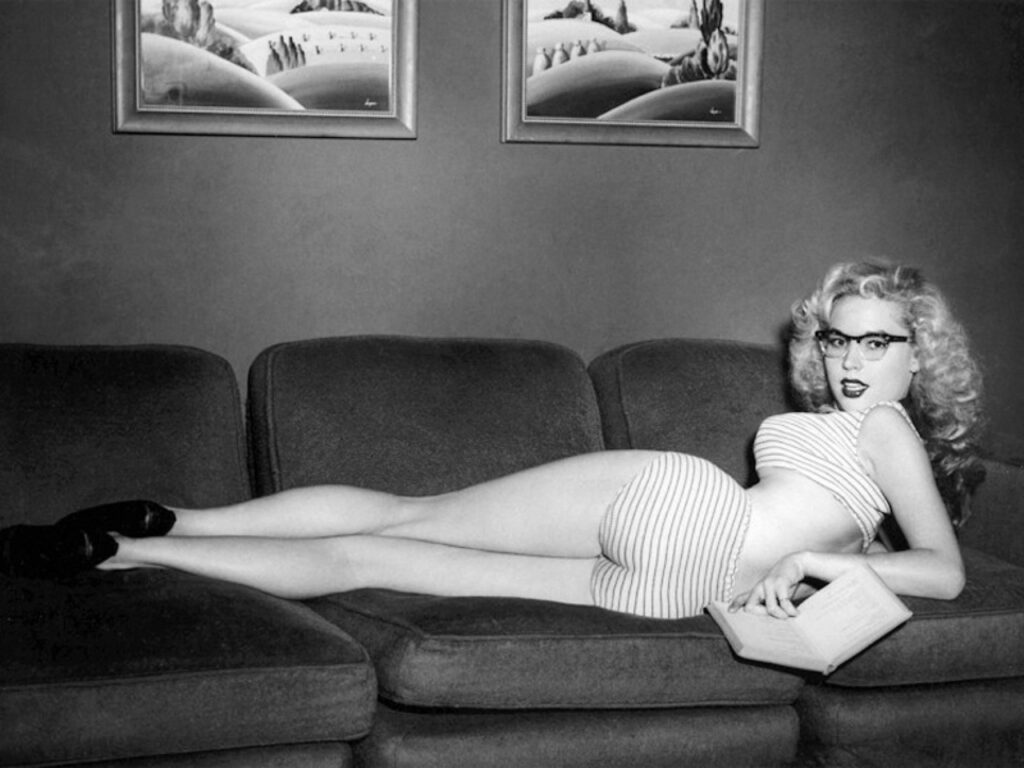
Her welcoming face, sometimes captured by Bernard in a “Who me?” pose, combined with her 5’5”, 112-pound body with its outrageous hourglass dimensions (39” bust, 19” waist, 36” hips) proved an irresistible pairing of innocent and sexy, the naughty librarian look. Frequently, she was mistaken for Marilyn Monroe. But no other model could match her minuscule middle, listed, variably, at 18, 19, or 20 inches and known as “the impossible waist” of Betty Brosmer.
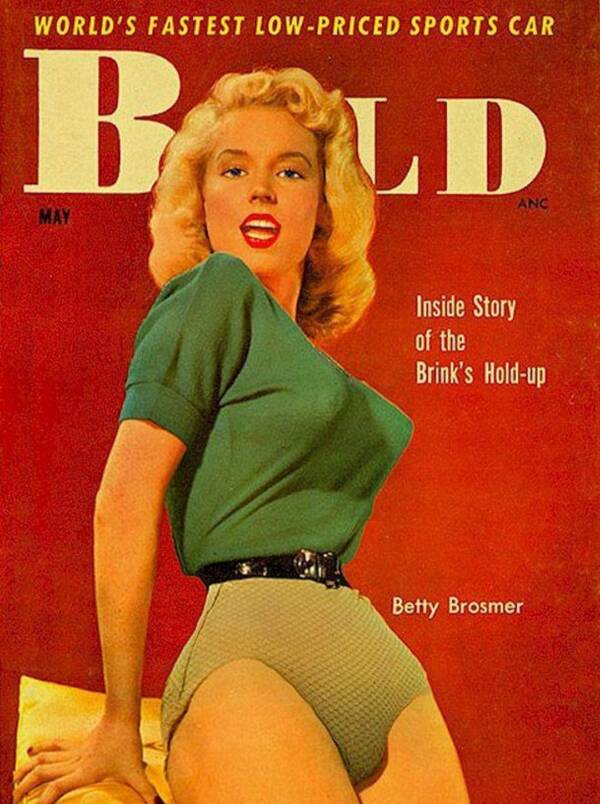
Bernard’s photos of Brosmer adorned the covers of more than 200 men’s magazines, including Carnival, Bold, Point, Rogue, Chicks and Chuckles, and Nugget.[17]
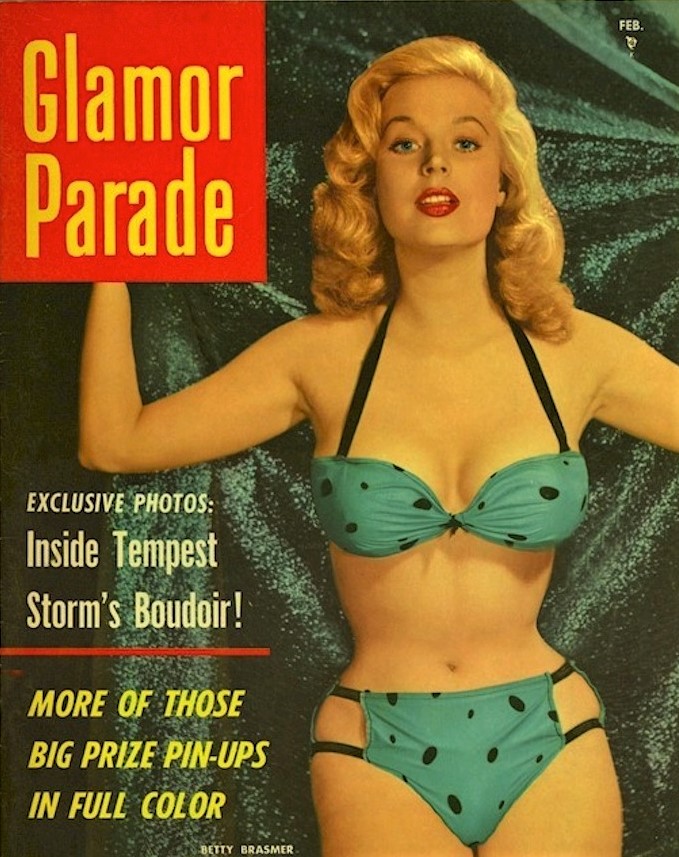
Additionally, Betty Brosmer did fashion and commercial shoots with other photographers. And her image appeared on the covers of diverse publications, including hardboiled pulps Crime Detective and Police Detective, photography magazines Art and Photography and Camera Art, and the British edition of the popular movie magazine Photoplay. For Chesterfield cigarettes, she smiled in magazine ads and on billboards; and, in a live TV commercial, she smoked for the only time, failing to mask her disgust. Around the world for years, life-sized cardboard cutouts of Betty Brosmer stood vigil in stores, promoting cameras and shoes and air fresheners. Her photos or paintings of her image also adorned sleazy “adult” paperbacks with titles like Lust Lodge, Naked Party, The Teaser, and Bed Crazy. Again and again, and well into the 1960s, her image was sold or appropriated.
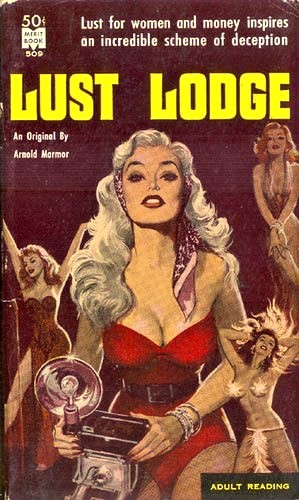
Unlike two other 5’5” blondes with hourglass figures, Marylin Monroe and Jayne Mansfield, Brosmer never parlayed her modeling into acting. Hollywood mogul Howard Hughes pursued Brosmer after spotting her with Aunt Annie at a Las Vegas revue, and Brosmer eventually met with Hughes’ assistant, but nothing came of it.[18] Brosmer never took an acting class or auditioned for a film or TV role. Coming of age near Hollywood, she had seen too many pretty girls herded through perpetual cattle calls. She didn’t want to chase that dream.
Like Aunt Annie, Betty loved to learn, and she haunted bookstores. Philosophy, politics, and psychology were favorite reading topics. She practiced Zen Buddhism and yoga. She painted in watercolors, cooked gourmet meals, and designed and sewed clothes. Her record collection favored classical, modern jazz, mambo, and blues. She attended art auctions and perused galleries, daydreaming about being rich enough to purchase her favorite pieces. She dated a TV executive and the son of a governor.
BETTY BROSMER BARE?
Of course, Playboy called. Keith Bernard shot Betty Brosmer for Hugh Hefner’s young, popular magazine, but the model kept her nipples in a demi-bra or behind playing cards during a faux strip poker game. Disappointed by the lack of nudity after paying the shoot’s expenses, Playboy sued Bernard and never used the photos.[19]
Throughout the 1950s, Betty nearly spilled out of bras, bikini tops, and robes, donned skin-tight shorts, struck countless come-hither poses, and held a martini while dressed in a sheer nightie cascading almost entirely off her chest (see below). But you never saw her breasts or butt completely bare. There was always just enough fabric, and perhaps retouching paint, in the way. (In 1963, Fling magazine featured a layout entitled “Last Fling With Betty Brosmer,” which seemed to reveal more than usual. Fling’s publisher later admitted he drew a nipple into cleavage shots.[20])
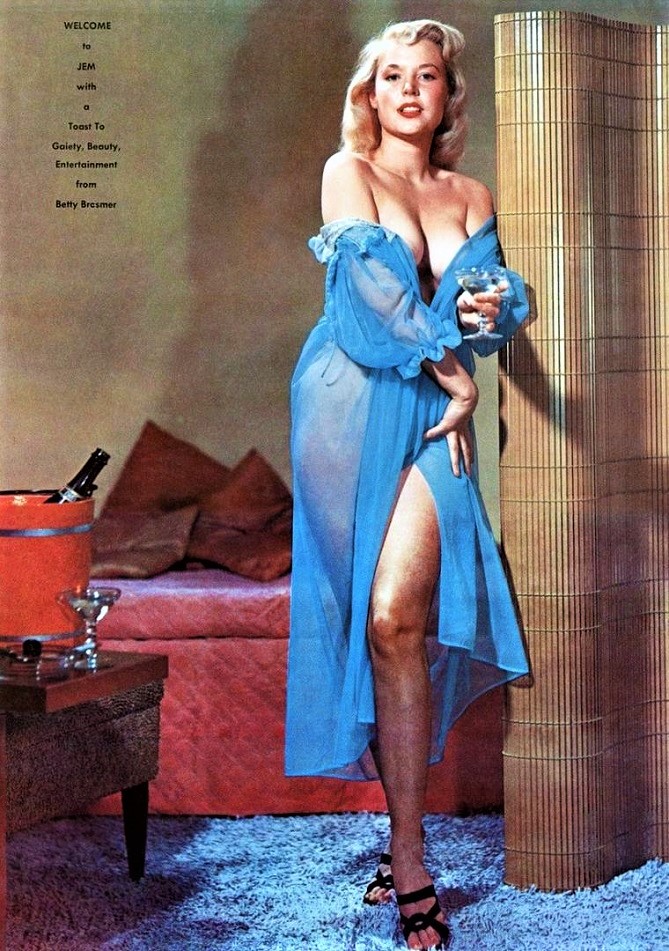
“I was asked by a number of photographers to pose semi-nude, but I always declined,” Betty later explained. “My main objective was that I never knew who I was going to marry. I thought it would embarrass my future husband and my family. I didn’t think it was immoral, but I just didn’t want to cause problems for others.”[21] Her showing almost-but-not-quite-everything only boosted her popularity above contemporaries who had no such compunctions. A 1956 Modern Man cover dubbed her “Hollywood’s Most Chased Chaste Pinup Girl Betty Brosmer.”
At the end of the 1950s and the start of the ’60s, an ad ran in men’s magazines, including Joe Weider’s, for 8mm or 16mm “ultra-revealing, provocative films” of Brosmer and sets of 12 or 48 photos (see below). She was seemingly dressed in only sandals and a sign, and the text promised “she’d finally consented to let her fans see more of her.” The description of Late Date, one of the black-and-white “action movies,” read: “Betty returns from a date, and after discouraging her too amorous swain, disrobes and prepares for bed. When you see her in all her glory, you’re going to wonder why he gave up so easily!”[22] Checks and money orders were payable to Betty Brosemer (her legal name). She profited from the collective desire to see her nude, and yet, despite the come-on, she showed no more than she did in her many magazine pinups.
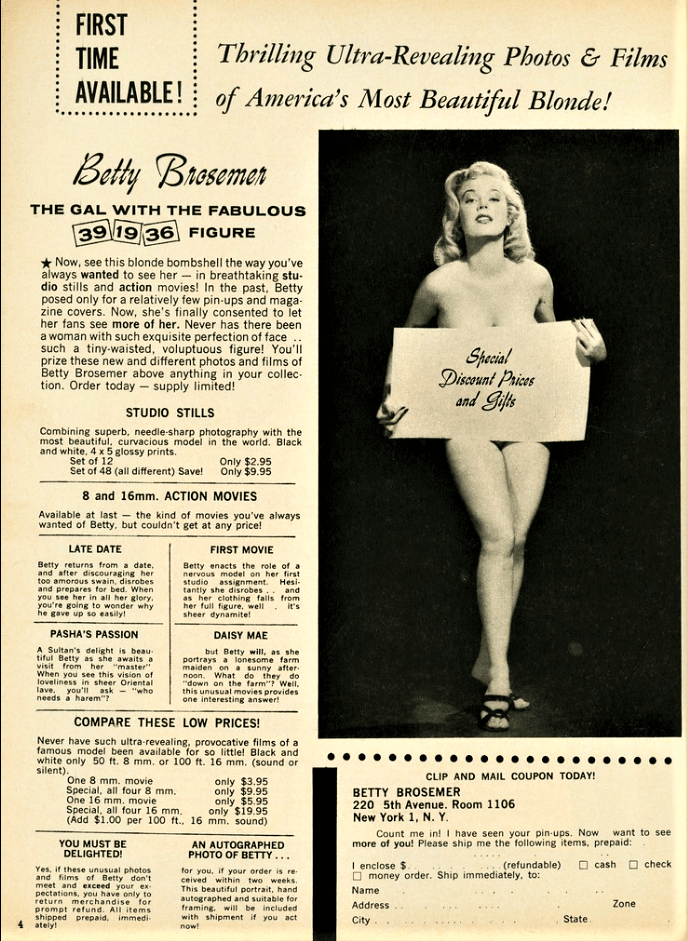
BETTY BROSMER’S AGE
In June 1955, a newspaper photo caption said Betty Brosmer, Miss Plumber’s Helper, was 19.[23] In a magazine profile in December 1956, she was also 19.[24] While maturing into her late 20s, she was stuck on 19—the ideal age for a beauty queen and pinup girl. Eventually, she settled on August 2, 1935, as her birthday, as virtually all sources say today. But, for those who did the math, the shedding of six years necessitated the creation of a very troubling origin story wherein she moved across the country to New York City in 1950 and, when not attending high school, was a child prodigy pinup model, supposedly first posing provocatively for men’s magazines that year at 14! In fact, she was 20. Census data reveals the future supermodel Betty Brosmer and first lady of fitness Betty Weider was born August 6, 1929.[25]
JOE WEIDER
Joe Weider (1920-2013) grew up in a Jewish ghetto in Montreal and launched his first muscle magazine, Your Physique, in 1940. He married the American Diana Ross (not that Diana Ross) in 1947 and moved to New Jersey, just across the Hudson from Manhattan. His business, which included instructional courses, weight sets, and other workout equipment, expanded. His highly profitable nutritional supplements launched in 1952. In the 1950s, Weider published not just a bodybuilding magazine—Muscle Builder, which supplanted Your Physique—but sports magazines (Boxing and Wrestling, Inside Baseball, etc.), pioneering women’s fitness/beauty magazines (Figure & Beauty, American Beauty), beefcake (Body Beautiful, Adonis) and cheesecake (Jem, Monsieur) magazines with male and female semi-nudity, and “SENSATIONAL!” men’s adventure magazines (Fury, American Manhood, Safari, True Weird, etc.).
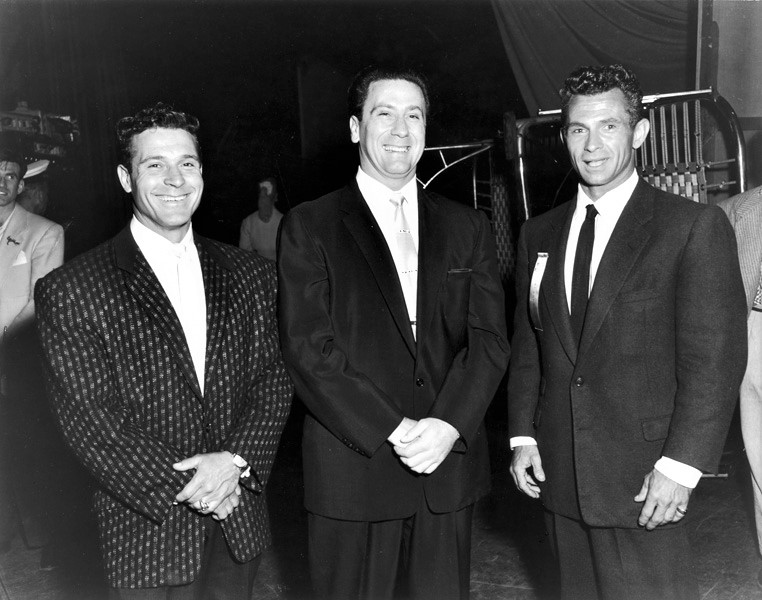
Sometime in the mid-50s, Joe Weider was seated with his magazine art directors at a window table in a favorite Times Square restaurant. Smiling at him from across the street was a blonde woman in a flowing dress, two stories tall on a billboard, probably hawking Chesterfield cigarettes. “That’s the most beautiful woman I’ve ever seen! She looks like an angel. Why can’t we get photos like that?” Weider asked.[26] That angel was Betty Brosmer, and Weider later purchased photos of her, taken by Keith Bernard.
Betty made her Weider magazine debut on the back cover of the October 1956 Fury with the strip poker photo never used by Playboy. The next month she had a four-page lingerie and swimsuit layout in Fury and the not-totally-revealing centerfold (see above) in the premiere issue of Jem, Weider’s Playboy knockoff. Thereafter, she appeared regularly in Weider’s men’s magazines.
“Meet Betty Brosmer—Our Newest Beauty Queen” is the title of a five-page article in the December 1956 Figure & Beauty. The byline is Joseph Weider’s, though that doesn’t guarantee he wrote it. Supposedly bucking the blonde stereotype, Brosmer is presented as bright and down-to-earth.[27] The latter half of the profile is essentially an advertisement for Weider’s Beauti-Belles (a pink weight set) and HEALTHRO (a bodyweight rowing device), with praise attributed to Betty, who is pictured training with Weider’s workout equipment, provocatively dressed, even lifting weights in high heels.
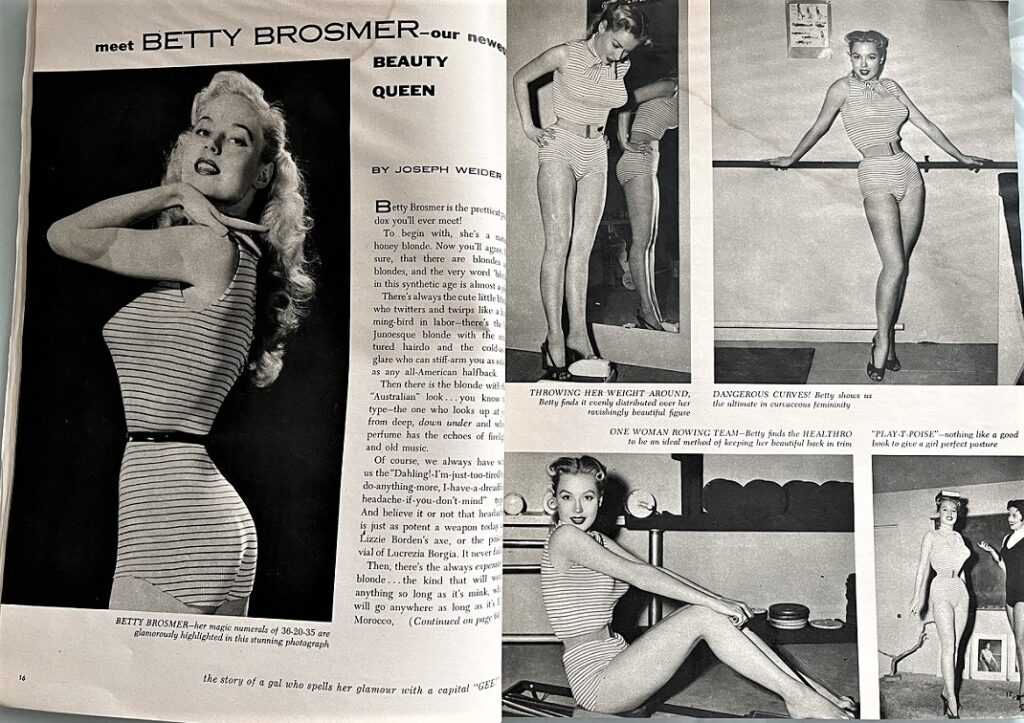
1957 was an eventful year for Joe Weider. His only child, daughter Lydia, was born in January. He moved his headquarters from Jersey City to a modern building, constructed to his liking, in neighboring Union City. And in June, the distributor of Weider’s 13 magazines abruptly went under. Joe Weider had only launched most of those magazines at the distributor’s behest and because the distributor fronted expenses. Money from newsstand sales halted, and soon bills and then lawsuits for unpaid bills arrived at the new Weider headquarters. Joe Weider paid off his great debts while maintaining his first-class lifestyle, but he jettisoned most of the new magazines over the next two years and focused his business again primarily on bodybuilding: magazines, workout equipment, courses, and—his biggest money maker—nutritional supplements.
A BETTY BROSMER PHOTOSHOOT
In Southern California in 1957, Betty rode in the back seat of a car with bodybuilder Dick DuBois, winner of the 1954 Mr. America, while in the front were photographers Russ Warner and Bob Delmonteque. A shot captured that day of DuBois and Brosmer smiling in swimsuits arm-in-arm on a dock adorns the December 1957 Muscle Builder, Brosmer’s first such appearance and a huge seller. The cover line calls her “Betsy Brosmer.” (Her name is also misspelled “Betsy” in the December 1956 Figure & Beauty table of contents.)
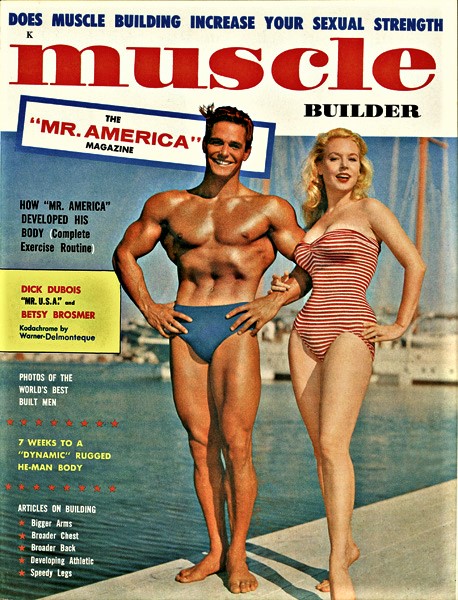
During the ride to and from the shoot, Brosmer and DuBois, who was then studying to become a Pentecostal preacher, conferred on atypical topics for a model and a muscleman, including philosophy, religion, poverty, and education.
Delmonteque turned and said to the model, “I have a friend in New York who’d fall madly in love with you.”
“Why would you say such a thing?” Brosmer asked.
“Because you share many of the same interests,” Delmonteque replied.[28]
That man was Joe Weider. Of course, Betty was shooting for a Weider magazine that very day, as she had a year prior for the Figure & Beauty article attributed to Joseph Weider, and she had appeared in and on Weider’s men’s magazines (in older photos). However, she had done so many shoots for so many products and publications they blurred together. She knew nothing about Joe Weider. And yet she was Joe Weider’s favorite model.
JOE AND BETTY: THE ROMANCE BEGINS
In late 1958, Betty Brosmer was back in New York City, cast in another Broadway play (this one was killed before she stepped on stage).[29] Reading this in a newspaper, Joe Weider contacted her agent and invited her to his Union City offices. She balked. They met instead in Manhattan at a photoshoot. On the way there, she remembered that he was the guy who was supposed to fall in love with her.[30] She found him “nice-looking” but “a little overweight and not fussy about grooming.”[31] Still, he was charming and endearingly earnest.
“We talked about his dreams and magazines,” she said. “He told me how he wanted to bring fitness to the world. At the time, he was almost a one-man publishing house, working 15 to 17 hours a day to rebuild what he had lost. I signed the contract [for photos of her to be used in his magazines and women’s exercise courses], even though I had received much better offers….I admired Joe, his beliefs and dedication to bringing something positive to the world.”[32]
Weider made a point of overseeing Brosmer’s photoshoots. “He requested me for a dozen more photo assignments, and after each session we would go out to lunch or dinner,” Betty remembered. “We talked on subjects of mutual interest—psychology, philosophy, and religion. There was no romance. I also gave him input to his magazines, opinions and ideas he valued a great deal.”[33]
Joe Weider recalled, “The more time I spent with Betty, the more I appreciated her good qualities and enjoyed her company. She was compassionate, a good listener, and the first woman I could really talk with. The better I knew her, the more she reminded me of my father. It must have been a relief for her, being with a man who wasn’t head over heels or trying to put the make on her….I think Betty was drawn to me because I reminded her of her father…”[34]
In the spring or summer of 1959, late in the evening after a photoshoot, Weider and Brosmer were alone together and dining on paella in Granada, a Spanish restaurant in Greenwich Village. The lights were low. Wine flowed. They looked into each other’s eyes, and he reached across the table and took her hand. It was the beginning of a romance that lasted 54 years.
INFEDELITIES
There was one big problem. Joe Weider was a married man, though not happily so. In fact, his marriage to Diana was in shambles, with each spouse suspecting the other of infidelity. On July 6, 1959, he moved into a guest room in City House, the crown jewel of the exclusive New York Athletic Club, looming over Central Park. He was the rare Jewish guest in a club criticized for its discrimination, but in the stately 24-floor building, an oasis in the bustling metropolis, he could swim and lift weights and get massages and consume gourmet meals.
The only recognized causes for a divorce in New Jersey then were adultery or desertion, the latter for at least two years. In New York there was only adultery. That’s why Joe Weider hired a $75-a-day private investigator to spy on his wife as she vacationed in Port-au-Prince, Haiti, in August 1959. The P.I., who checked into a hotel suite next to Diana’s, watched Diana with a glass-bottom boat operator, “one of Haiti’s most debonair men and charming bachelors about town,” for four nights.[35] On one occasion, both were partially undressed and making out on the suite’s patio before disappearing into the room.[36]
Meanwhile, when Joe Weider and Betty Brosmer traveled to Joe’s hometown of Montreal, in November 1959, Diana hired a French-Canadian private investigator to tail them. The 270-pound P.I. watched Weider’s room in the luxurious hotel The Queen Elizabeth. At 1:10 AM, Joe and Betty strolled affectionately from the elevator to the room.[37] After they disappeared inside, the P.I. put his ear to the door. Though confronted by the hotel’s detective and night manager, the P.I. was undeterred.
Accompanied by four henchmen, at 2:30 AM, the P.I. knocked on the door, and, when Joe Weider answered, the quintet barged in.[38] Purportedly, Joe was wearing only an undershirt and Betty only a bra and panties.[39] Outraged, Weider insisted Brosmer was his bride. “This lady is not your wife,” the P.I. replied. “Your wife happens to be waiting in my room.”[40] Joe didn’t believe him until he was led to a neighboring room, where the flabbergasted muscle mogul was confronted by irate Diana.[41]
JOE WEIDER’S DIVORCE
First in January 1960 and then in October, the Port-au-Prince and Montreal tales unfurled in a Manhattan courtroom as well as New York tabloids and in wire service stories throughout the country. When Joe had sued Diana for divorce on grounds of adultery, she had countersued on the same grounds, seeking $18,200 in annual alimony (plus a $10,000 counsel fee) from his $100,000-a-year income.[42] (In today’s dollars: $182,497, $100,273, and $1,002,730.) The national focus was foremost on Betty Brosmer. When the case was introduced that January, a typical headline read: “Girlie Magazine Model Is Named In Divorce Case.” The New York Daily News, in its incessant coverage, repeatedly referred to Joe Weider as “runner-up for Mr. America and Mr. Canada.” (He was neither. He competed in bodybuilding only once, unsuccessfully, at age 40, in the 1951 Mr. Universe.)
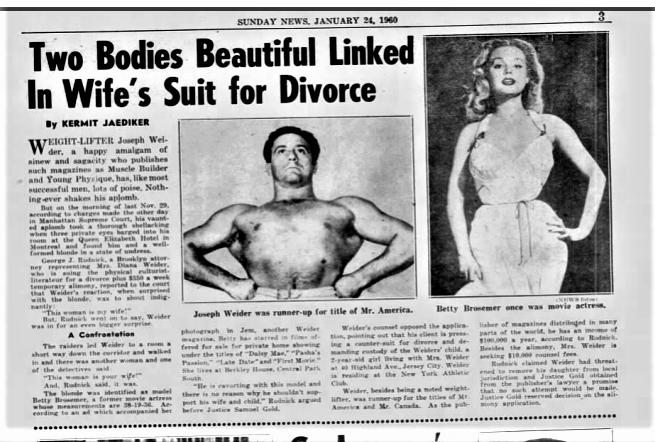
Neither lawsuit was the slam dunk each originally seemed. Diana’s lawyer focused on the lack of photographic evidence, while she denied any romance and claimed a pelvic malady would have prevented her from engaging in the described foreplay. Joe’s defense presented an innocent, if ludicrous, explanation to counter the P.I.’s testimony. Weider claimed that he and Brosmer were in Montreal to work for his brother Ben’s French-language bodybuilding magazine; and, because Joe was coming down with a cold, Betty was drawing him a foot-soaking bath as a kindly, medicinal gesture. He and she were fully dressed, and witnesses who testified otherwise “must have been watching an old French movie on the hotel room TV”![43] Brosmer’s attorney claimed she was wearing a two-piece black suit and a pair of galoshes![44] Taking the stand in a grandmotherly dress and eyeglasses, Betty testified to the same.
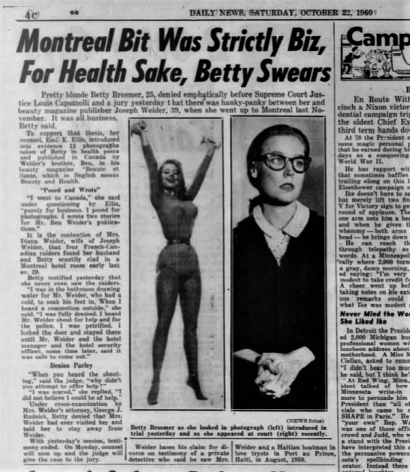
On October 24, 1960, the jury reached companion verdicts: Joe and Diana Weider were each innocent of adultery. The double win was a double loss, because the estranged couple was still legally bound in a ravaged marriage.
Reno and Las Vegas were the easiest places in America to attain a divorce then. Of the nine grounds for divorce there, mental cruelty was the most common, with no proof necessary. Though you needed to be a Nevada resident, you only had to stay in the state six weeks to achieve residency. Thus, the divorce trade was a boon to Nevada’s tourist industry. Weider and Brosmer moved into a small apartment on an unpaved street (now Convention Center Drive), off the north Las Vegas Strip.
“Vegas cast a spell on me,” Joe Weider said. “I loved the desert—the clean, stark beauty, the clarity of the light, the pure air…”[45] He and his bride-to-be didn’t gamble and rarely drank, but they enjoyed the Rat Pack era nightlife in the ostentatious hotels, which seemed to have flowered out of the Mojave Desert. And in the sunlight, they were seduced by the affability of what still felt like a small, western town. Weider worked on his magazines, consulting with editors in Union City by telephone. The couple stayed six months.
After 14 years of marriage, Joseph and Diana Weider divorced. “Relieved as I was to end my first marriage, it also brought terrible pain,” Joe Weider remembered. “We had a little daughter [Lydia] in her toddler years, and my ex-wife cut off contact completely. I provided support through our attorneys, but to me, my ex-wife and daughter dropped off the map. For years I had no idea where she was.”[46] (In 1962, Diana married a man in Florida.)
THE MUSCLE MAN’S GIRL FRIEND
From the November 1959 Monsieur to the June 1960 Jem, Betty Brosmer was on seven of eight covers of Weider’s two, short-lived Playboy knockoffs. When she returned to a Jem cover in January 1961, it marked the end of her men’s magazine career (though old photos resurfaced and were repurposed), while her fitness career, destined to last much longer, had only just launched.
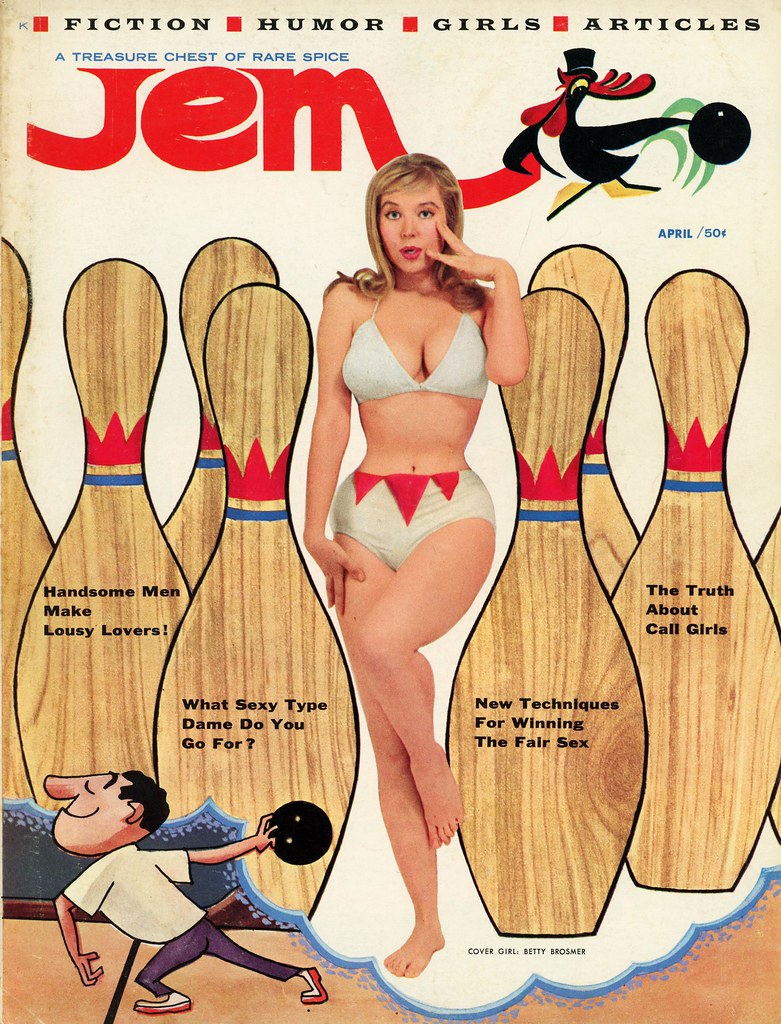
When she adorned the cover of the May 1960 Muscle Builder, grinning with eyes closed as she fondled a bodybuilder’s flexed biceps, the caption called her “the Muscle Man’s Girl Friend, Betty Brosmer”—an early step in her rebranding as well as Joe Weider’s favorite cover motif: babe-admires-bodybuilder.
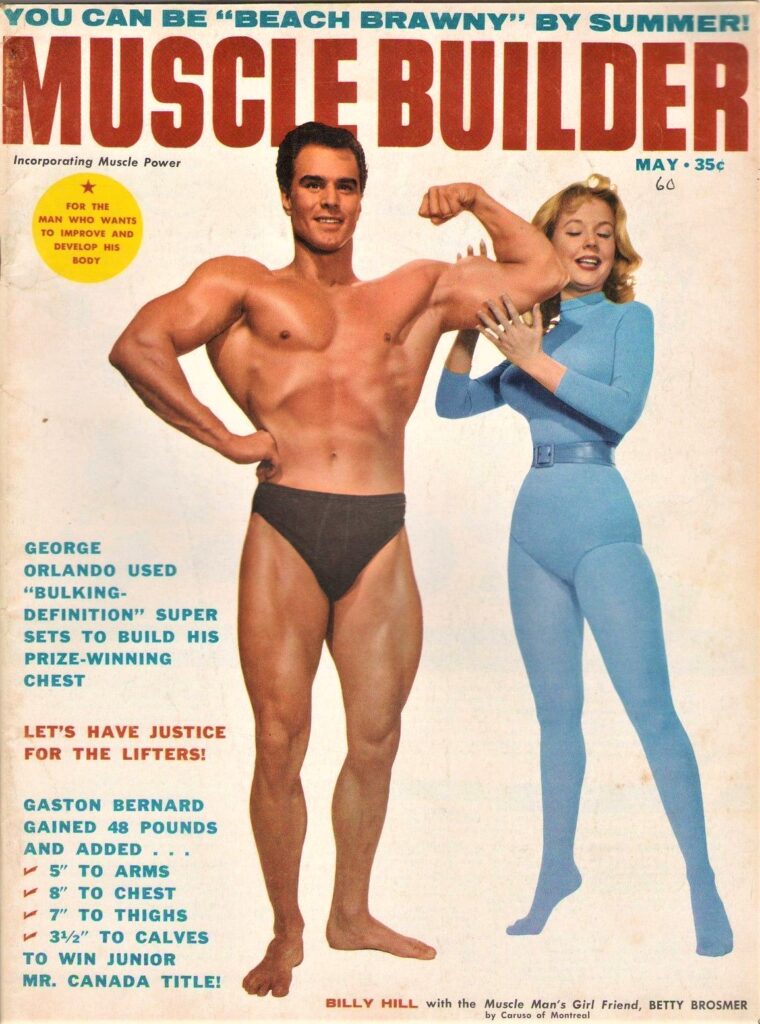
For the rest of the 1960s and then the 1970s and then the 1980s, Betty Weider would be seen in similar photos, on Weider covers, in Weider articles, and in Weider advertisements, with Larry Scott, Dave Draper, Arnold Schwarzenegger, Frank Zane, and many more champion bodybuilders.
JOE AND BETTY WEIDER: THE WEDDING
As a companion to quickie divorces, Las Vegas served up quickie marriages. On April 24, 1961, 31-year-old Betty Chloe Brosemer and 40-year-old Joseph Weider wed in The Little Church of the West, a rustic replica of a typical pioneer church and a Vegas landmark since 1942. The price was $25. Though none of his family journeyed from Montreal, her father, sister, and Aunt Annie traveled from neighboring California to witness the milestone. At a small reception at the Riviera Hotel, the newlyweds toasted their union and playfully fed each other slices of cake, and they kissed before the photographer’s clicking shutter.
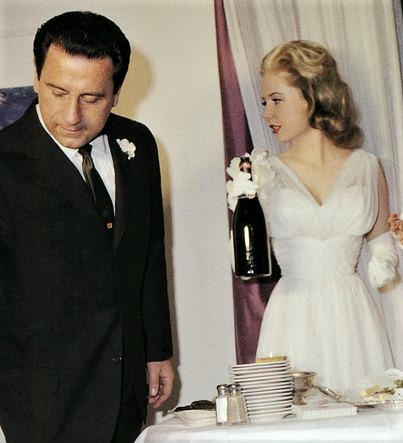
POSTSCRIPT: BETTY WEIDER
On the February 1962 Muscle Builder cover, there was Betty again on the dock with Dick DuBois in another photo from the 1957 shoot. It worked once, why not twice? Ten months after her marriage, the caption still referred to Betty Weider as Betty Brosmer.
She received her first byline as Betty Weider in the premiere issue of Weider’s short-lived general interest fitness magazine, Vigor, in March 1963. She was the women’s editor and had bylines in every issue. Eventually, Betty Weider became a worldwide fitness icon—ubiquitous Weider muscle magazine cover model, prolific magazine columnist and editor and exercise book co-author, and the face and figure of numerous Weider workout and nutrition products. But until at least 1963, the girl from Watsonville with the impossible waist was still known almost entirely by her former name from her former career as the ultimate pinup model of the 1950s.
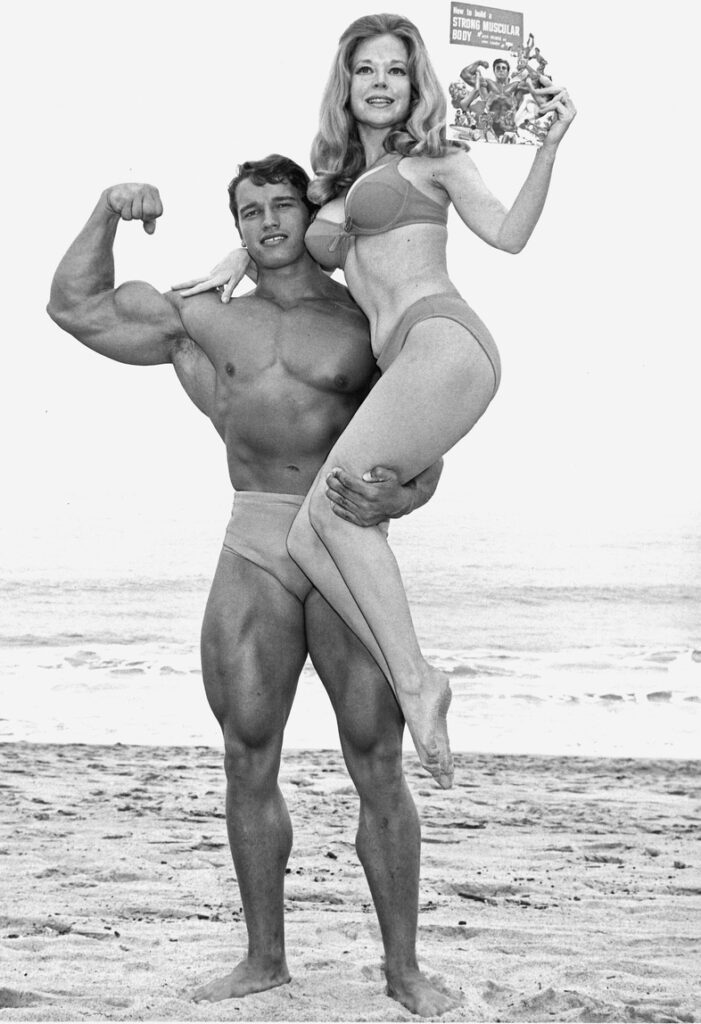
SOURCES
[1] “Confederate of John Dobbins is Fined $200,” Santa Cruz Evening News, Jan. 13, 1923, 4.
[2] 1930 Census, Watsonville, Santa Cruz, California; Roll: 215; Page: 7B; Enumeration District: 0028; Image: 846.0; FHL microfilm: 2339950; 1940 Census, Watsonville, Santa Cruz, California; Roll: T627_343; Page: 5B; Enumeration District: 44-34.
[3] “Under Advisement,” Santa Cruz Sentinel, June 4, 1932, 7.
[4] Sullivan, Steve, Va Va Voom!: Bombshells, Pinups, Sexpots and Glamour Girls (Los Angeles: General Publishing Group, Inc., 1995), 215.
[5] “Divorce Sought in Desertion Charge,” San Bernardino County Sun (San Bernardino, CA), Feb. 20, 1940, 12.
[6] “Obituary: Annie Brosemer,” Calaveras Enterprise, July 18, 2003.
[7] Bernstein, Sandy, “Meet the Woman Behind Fitness Publishing Mogul Joe Weider,” Journal of Longevity, Vol. 13, No. 9, 2007, 37.
[8] Ibid, 38.
[9] Sullivan, Steve, 216.
[10] Ibid, 216.
[11] Lovisi, Gary, “Who’s That Girl? A Celebration of, and Interview with, Betty Brosmer,” Paperback Parade #70, July 2008, 34.
[12] “Ken Murray, 85; Producer of WWII Revue, Actor,” Los Angeles Times, Oct. 13, 1988; Sullivan, Steve, 215.
[13] Sullivan, Steve, 216.
[14] Ibid, 217.
[15] Walter Winchell column, “Argus Leader (Sioux Falls, South Dakota),” July 17, 1954, 1.
[16] Sullivan, Steve, 218.
[17] Glamour Photographers of the 1950s and 60s, glamourphotographers.yolasite.com.
[18] Sullivan, Steve, 221.
[19] Ibid, 220.
[20] Ibid, 224.
[21] Ibid.
[22] Advertisement, Betty Brosemer, Monsieur, March 1960, 4.
[23] “Miss Plumber’s Helper,” Los Angeles Times, June 17, 1955, 2-28.
[24] Weider, Joseph, “Meet Betty Brosmer—Our Newest Beauty Queen,” Figure & Beauty, Dec. 1956, 64.
[25] 1930 Census, Watsonville, Santa Cruz, California; Roll: 215; Page: 7B; Enumeration District: 0028; Image: 846.0; FHL microfilm: 2339950; 1940 Census, Watsonville, Santa Cruz, California; Roll: T627_343; Page: 5B; Enumeration District: 44-34.
[26] Bernstein, Sandy, 38.
[27] Weider, Joseph, 64.
[28] Bernstein, Sandy, 38.
[29] Zolotow, Sam, theater column, New York Times, Dec. 30, 1958.
[30] Sullivan, Steve, 223.
[31] Bernstein, 39.
[32] Ibid.
[33] Sullivan, Steve, 223.
[34] Weider, Joe and Ben Weider with Mike Steere, Brothers in Iron (Champaign, IL: Sports Publishing, LLC, 2006), 122.
[35] Hattenbach, Anthony, Stars Over Haiti: A True Story (Miami, Florida: Ahat Enterprises, Inc., 1993), 4; “4 Naughty Nights of Love ‘n Haiti,” Philadelphia Daily News, Oct. 12, 1960, 5.
[36] “4 Naughty Nights.”
[37] “Haiti to Canada: It Stays Torrid,” Philadelphia Daily News, Oct. 14, 1960, 5.
[38] “Girlie Magazine Model Is Named In Divorce Case,” Anderson Daily Bulletin (Anderson, Indiana), Jan. 7, 1960, 29.
[39] “Corset-Girdle Tiff Stretches Out, Binds Court,” Philadelphia Daily News, Oct. 15, 1960, 3.
[40] “Haiti to Canada.”
[41] Ibid.
[42] “Model Named in Divorce of Publisher,” Oakland Tribune, Jan. 6, 24E.
[43] “Muscleman Claims Mr. Clean Role,” Philadelphia Daily News, Oct. 21, 1960, 3.
[44] “4 Naughty Nights.”
[45] Weider, Joe and Ben Weider with Mike Steere, 124.
[46] Ibid.



































